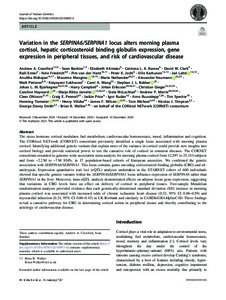Variation in the SERPINA6/SERPINA1 locus alters morning plasma cortisol, hepatic corticosteroid binding globulin expression, gene expression in peripheral tissues, and risk of cardiovascular disease
Crawford Andrew A.; Bankier Sean; Altmaier Elisabeth; Barnes Catriona L. K.; Clark David W.; Ermel Raili; Friedrich Nele; van der Harst Pim; Joshi Peter K.; Karhunen Ville; Lahti Jari; Mahajan Anubha; Mangino Massimo; Nethander Maria; Neumann Alexander; Pietzner Maik; Sukhavasi Katyayani; Wang Carol A.; Bakker Stephan J. L.; Bjorkegren Johan L. M.; Campbell Harry; Eriksson Johan; Gieger Christian; Hayward Caroline; Jarvelin Marjo-Riitta; McLachlan Stela; Morris Andrew P.; Ohlsson Claes; Pennell Craig E.; Price Jackie; Rudan Igor; Ruusalepp Arno; Spector Tim; Tiemeier Henning; Völzke Henry; Wilson James F.; Michoel Tom; Timpson Nicolas J.; Smith George Davey; Walker Brian R.; CORtisol NETwork (CORNET) consortium
https://urn.fi/URN:NBN:fi-fe2021042825658
Tiivistelmä
The stress hormone cortisol modulates fuel metabolism, cardiovascular homoeostasis, mood, inflammation and cognition. The CORtisol NETwork (CORNET) consortium previously identified a single locus associated with morning plasma cortisol. Identifying additional genetic variants that explain more of the variance in cortisol could provide new insights into cortisol biology and provide statistical power to test the causative role of cortisol in common diseases. The CORNET consortium extended its genome-wide association meta-analysis for morning plasma cortisol from 12,597 to 25,314 subjects and from similar to 2.2 M to similar to 7 M SNPs, in 17 population-based cohorts of European ancestries. We confirmed the genetic association with SERPINA6/SERPINA1. This locus contains genes encoding corticosteroid binding globulin (CBG) and alpha 1-antitrypsin. Expression quantitative trait loci (eQTL) analyses undertaken in the STARNET cohort of 600 individuals showed that specific genetic variants within the SERPINA6/SERPINA1 locus influence expression of SERPINA6 rather than SERPINA1 in the liver. Moreover, trans-eQTL analysis demonstrated effects on adipose tissue gene expression, suggesting that variations in CBG levels have an effect on delivery of cortisol to peripheral tissues. Two-sample Mendelian randomisation analyses provided evidence that each genetically-determined standard deviation (SD) increase in morning plasma cortisol was associated with increased odds of chronic ischaemic heart disease (0.32, 95% CI 0.06-0.59) and myocardial infarction (0.21, 95% CI 0.00-0.43) in UK Biobank and similarly in CARDIoGRAMplusC4D. These findings reveal a causative pathway for CBG in determining cortisol action in peripheral tissues and thereby contributing to the aetiology of cardiovascular disease.
Kokoelmat
- Rinnakkaistallenteet [27094]
